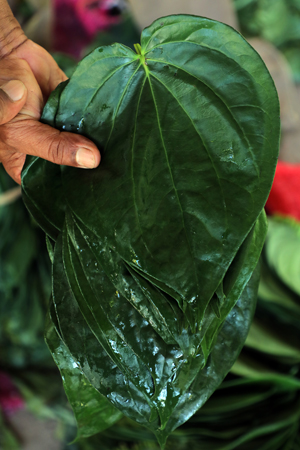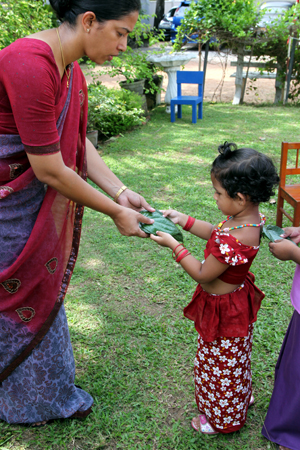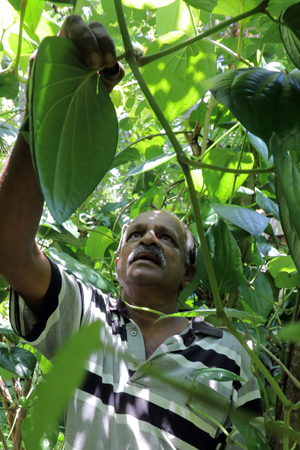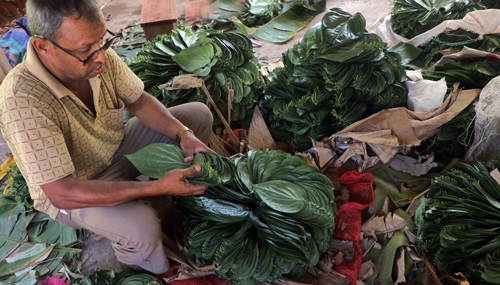What would avurudu be without bulath
 Nimal Samaratunga sits in his shed in the backwoods of Minuwangoda, half hidden amidst veritable mountains of betel leaves. Selling ‘bulath’ is not only his trade, it was also his father’s, grandfather’s and great-grandfather’s too. The lattter was called ‘Bulath-Simon Aatha’ (grandfather). Today Nimal’s own son is learning the ropes.
Nimal Samaratunga sits in his shed in the backwoods of Minuwangoda, half hidden amidst veritable mountains of betel leaves. Selling ‘bulath’ is not only his trade, it was also his father’s, grandfather’s and great-grandfather’s too. The lattter was called ‘Bulath-Simon Aatha’ (grandfather). Today Nimal’s own son is learning the ropes.As Avurudu – the sun festival with golden paddy harvest- is around the corner, betel becomes indispensable. This is telling of the connection between bulath, prosperity and the Sinhalese (and indeed many an Indic) people – a connection that is celebrated in the antiquated phrase ‘bathin bulathin saruwewa’- basically ‘may your life be bountiful with rice and betel’.
But why betel? A clue is gleaned when we see Nimal worshipping each sheaf of the leaves he stacks. During Avurudu, betel assumes its role of a blessed object. It is offered to elders before they are worshipped, money is handed wrapped in bulath and oil is anointed with a bulath leaf.
In the Hindu New Year customs bulath, called Nagavalli, is just as central. While it is the betel nut that is more pivotal to Hindu traditions, the leaf is used in worship and transactions (giving and receiving money) while two leaves alongside two plantains and half a coconut form a religious offering.
The belief is that bulath came from the Naga (the divine serpent) world. In the Jataka tales is the story of the bodhisattva hare who, for offering his flesh to a beggar (as bodhisattvas are wont to do), was painted on the moon to perpetuate his generosity.
But then, the king of gods after painting let the gold brush fall and it landed in the Naga world, where the Naga king consumed it and died. From his divine scaly carcass sprang the betel vine.
The connection comes with the similarity between the cobra’s hood and the leaf.

A time-honoured Avurudu tradition
It was Arjuna of the Mahabharata who went to heaven and brought the plant to the human world.
Similar legends have it that earthlings did not know bulath till the Pandavas wanted to celebrate conquering the Hasthinapur kingdom and sent a messenger to Vasuki, the queen of the Nagas. She cut a digit of her little finger and advised to plant it so betel would grow. This, says hoary tradition, is why parts of the branches only can regenerate.
A betel farmer has to be assiduously clean given he is dealing with something sacred, if not divine. No oil or cream on hair, says one former cultivator, adding that the part of the leaf called palu-kan is offered to god Kataragama.
The current price for a thousand leaves of this heart shaped cousin of pepper is 5000 to 6000 Rupees. The quality of the leaf is gleaned by how fleshy it is. To be plucked, a leaf going to the local market should be at least 14 days old; for export, 21 days.
It seems the craft of harvesting and sorting bulath verges on the artisanal. After 40 years Nimal confesses he is far from being an expert; neither does he know anyone who can claim complete mastery.
In Minuwangoda, the bulath koratu (nurseries) in the backyards thrive healthily in shadows with an emerald glow and Nimal alone has about 400 farmers supplying him, plying the bundles in bicycles and trishaws. Export business, once lucrative, has now come to a temporary standstill due to the economic crisis in Pakistan.

A bulath nursery
“Imran Khan apahu awoth okkoma hari” (all will be well if Imran Khan comes back) laughed one old timer stoically, showing date-like betel stained teeth.
A sheaf of betel, called atha, gonna or hurulla, comprises 40 leaves while half sheaves of 20 are available.
Basically there are two grades of bulath- ‘peedichcha’ which is better than ‘kanda kola’.
One of the larger, more urban vendors is Lasitha Ravindra (39) who has a warehouse. We walk into a high-ceilinged murky, damp barn-like structure where in half-darkness many are busily bent over tattus (in jute baskets) of betel, arranged in a way that resembles an apple tart. Each ranging from 5000 to 6000 Rupees, he says around 30 to 40 tattu gets sold twice a week.
“We get the betel leaves from Ballapana, Kuliyapitiya, Kandanegedara, Divulapitiya and neighbouring areas; but this year sales have been comparatively low,” says Lasitha.
Probably part of bulath’s sanctity is in its medicinal value. Eating bulath alone is said to have 13 health benefits (though the accompaniments- chunam, arecanut and tobacco- are very unhealthy). It is anti-diabetic, anti-cancer, anti-microbial, anti-asthmatic and anti-malarial and has benefits for those with Leukemia. It also has gastro-protective activity, improves oral health, helps in wound healing and is said to even help ease depression.
In still semi-rural areas like Minuwangoda the ‘heavenly’ crop thrives and shows no signs of dwindling. It is reassuring to know that this boon companion of ours whether at a wedding, funeral or indeed any auspicious or special occasion, is still very much present in our collective psyche.

Stacking betel leaves with care: Nimal Samaratunga a betel leaf seller like his father, grand father and great grandfather before him. Pix by M.A. Pushpa Kumara
Searching for an ideal partner? Find your soul mate on Hitad.lk, Sri Lanka's favourite marriage proposals page. With Hitad.lk matrimonial advertisements you have access to thousands of ads from potential suitors who are looking for someone just like you.


